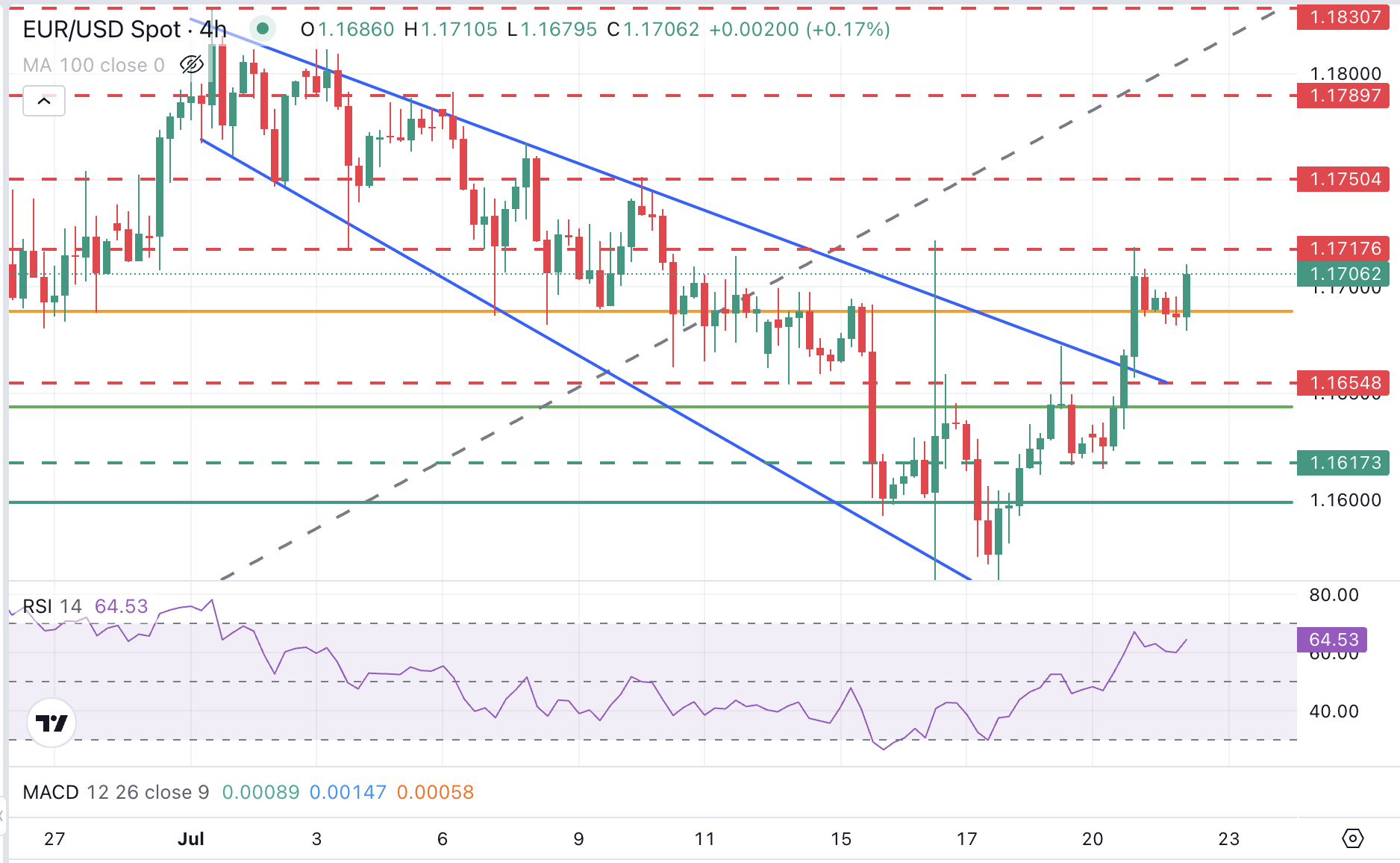- The Euro appreciates further on a positive ECB Lending Survey and a softer US Dollar.
- The US Dollar has lost momentum on growing concerns about Trump’s tariffs.
- Fed Chairman Powell will speak on Tuesday amid pressures to resign from President Trump.
The EUR/USD pair appreciates further on Tuesday’s European morning session with the US Dollar on its back foot as trade uncertainty grows ahead of the August 1 deadline, while a rather positive Lending survey from the European Central Bank (ECB), released earlier on the day, has provided additional support to the common currency.
The Euro (EUR) has turned positive on the daily chart and returned above the 1.1700 level. The pair remains above Friday’s high, at 1.1675, and also above the top of a bearish channel from July 1 highs, which suggests that further appreciation is likely.
The ECB’s survey indicates that trade tensions did not impact credit standards, and mortgage and corporate credit demand rose in the second quarter, with expectations of further increases over the next three months. These figures come after another upbeat report on access to finance released on Monday.
These reports are contributing to underpin the Euro near 10-day highs, yet with upside attempts limited on Tuesday as investors’ appetite for risks remains weak, with trade uncertainty weighing on sentiment as the August 1 tariff deadline approaches without significant progress in the negotiations.
EU and US representatives keep negotiating in an attempt to reach a deal, but hopes of a successful outcome diminish by the day. Recent comments from the European side reflect that confidence in a deal is waning and the bloc is exploring retaliatory measures. Some countries are considering wide-ranging anti-coercion measures targeting US services as a response to the hefty unilateral levies announced by US President Donald Trump.
Later on the day, Federal Reserve’s (Fed ) Chairman Jerome Powell’s speech in Washington will grab some attention. The Fed chair is not expected to comment on monetary policy as the Fed is within its blackout period ahead of the interest-rate decision on July 30, but his reaction to the unprecedented pressures from the US administration might have some impact on the market.
Euro PRICE Today
The table below shows the percentage change of Euro (EUR) against listed major currencies today. Euro was the strongest against the New Zealand Dollar.
| USD | EUR | GBP | JPY | CAD | AUD | NZD | CHF | |
|---|---|---|---|---|---|---|---|---|
| USD | -0.09% | -0.01% | 0.07% | -0.03% | 0.12% | 0.21% | -0.09% | |
| EUR | 0.09% | 0.10% | 0.19% | 0.08% | 0.20% | 0.39% | 0.03% | |
| GBP | 0.01% | -0.10% | 0.08% | -0.02% | 0.10% | 0.22% | -0.08% | |
| JPY | -0.07% | -0.19% | -0.08% | -0.08% | 0.04% | 0.22% | -0.22% | |
| CAD | 0.03% | -0.08% | 0.02% | 0.08% | 0.13% | 0.26% | -0.05% | |
| AUD | -0.12% | -0.20% | -0.10% | -0.04% | -0.13% | 0.14% | -0.22% | |
| NZD | -0.21% | -0.39% | -0.22% | -0.22% | -0.26% | -0.14% | -0.36% | |
| CHF | 0.09% | -0.03% | 0.08% | 0.22% | 0.05% | 0.22% | 0.36% |
The heat map shows percentage changes of major currencies against each other. The base currency is picked from the left column, while the quote currency is picked from the top row. For example, if you pick the Euro from the left column and move along the horizontal line to the US Dollar, the percentage change displayed in the box will represent EUR (base)/USD (quote).
Daily digest market movers: The US Dollar loses footing amid trade uncertainty
- The US Dollar seems to have lost the bullish momentum seen over the recent weeks. The Greenback is ticking up on Tuesday, but the last two days’ reversal suggests that the market is starting to become anxious about the impact of tariffs as the August 1 deadline approaches.
- In the absence of key macroeconomic releases, the continuous attacks from the US administration on Fed Chair Jerome Powell keep attracting investors’ attention, eroding the independence of the US central bank and the US Dollar’s status as reserve currency.
- In the Eurozone, on Monday, an ECB survey on access to finances showed that European firms are positive about their growth outlook, yet wary about the potential impact of trade tensions. The Euro appreciated following the release of the survey.
- Investors will also be attentive to the quarterly earnings of tech megacaps Alphabet and Tesla, while in Europe, the results of SAP, the region’s largest software maker, will provide some clues about the impact of a strong currency on European companies’ revenue.
EUR/USD breaks above trendline resistance and looks at 1.1720

EUR/USD is showing mounting bullish momentum after breaking the top of a downtrend channel from July 1 highs. The pair is ticking lower on Tuesday, but technical indicators are pointing higher with the 4-hour Relative Strength Index and the MACD moving within bullish territory.
Immediate resistance lies at 1.1720, which capped bulls on Monday, ahead of the July 10 high at 1.1750 and the July 7 high at 1.1790.
On the downside, the pair may find support at the July 18 high at 1.1675, but a retest to the reverse trendline, now at 1.1655, should not be discarded. A bearish reaction below that level would cancel the bullish view and bring Monday’s low, at 1.1620, to the focus.
Euro FAQs
The Euro is the currency for the 19 European Union countries that belong to the Eurozone. It is the second most heavily traded currency in the world behind the US Dollar. In 2022, it accounted for 31% of all foreign exchange transactions, with an average daily turnover of over $2.2 trillion a day.
EUR/USD is the most heavily traded currency pair in the world, accounting for an estimated 30% off all transactions, followed by EUR/JPY (4%), EUR/GBP (3%) and EUR/AUD (2%).
The European Central Bank (ECB) in Frankfurt, Germany, is the reserve bank for the Eurozone. The ECB sets interest rates and manages monetary policy.
The ECB’s primary mandate is to maintain price stability, which means either controlling inflation or stimulating growth. Its primary tool is the raising or lowering of interest rates. Relatively high interest rates – or the expectation of higher rates – will usually benefit the Euro and vice versa.
The ECB Governing Council makes monetary policy decisions at meetings held eight times a year. Decisions are made by heads of the Eurozone national banks and six permanent members, including the President of the ECB, Christine Lagarde.
Eurozone inflation data, measured by the Harmonized Index of Consumer Prices (HICP), is an important econometric for the Euro. If inflation rises more than expected, especially if above the ECB’s 2% target, it obliges the ECB to raise interest rates to bring it back under control.
Relatively high interest rates compared to its counterparts will usually benefit the Euro, as it makes the region more attractive as a place for global investors to park their money.
Data releases gauge the health of the economy and can impact on the Euro. Indicators such as GDP, Manufacturing and Services PMIs, employment, and consumer sentiment surveys can all influence the direction of the single currency.
A strong economy is good for the Euro. Not only does it attract more foreign investment but it may encourage the ECB to put up interest rates, which will directly strengthen the Euro. Otherwise, if economic data is weak, the Euro is likely to fall.
Economic data for the four largest economies in the euro area (Germany, France, Italy and Spain) are especially significant, as they account for 75% of the Eurozone’s economy.
Another significant data release for the Euro is the Trade Balance. This indicator measures the difference between what a country earns from its exports and what it spends on imports over a given period.
If a country produces highly sought after exports then its currency will gain in value purely from the extra demand created from foreign buyers seeking to purchase these goods. Therefore, a positive net Trade Balance strengthens a currency and vice versa for a negative balance.

